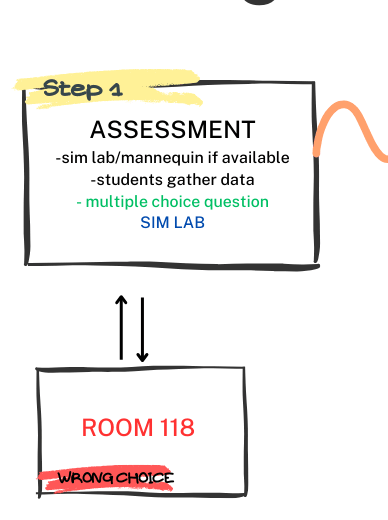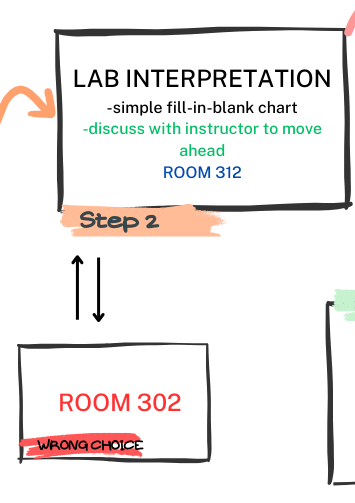Advanced Learning Stations - A “Moving Case Study” as a Tool for Nurse Educators
Previously, I posted an article about how to use basic stations effectively. Stations are a form of embodied learning that involves using our senses and movement to connect our brains to the learning experience. If you are interested in learning more about this concept, I highly recommend Dr. Susan Hrach’s book Minding Bodies.
This article extends that idea to a more advanced type of station activity. In this version, the stations are sequential and must be done in order because they follow a patient's care plan or a clinical judgment model of your choice.
⚡A special thank you to my friend Laura Stephenson. This article is inspired by an activity she created, which we used for years teaching together. I hope we can work together again soon. …
Moving Case Study
It is easiest to build this activity from an existing case study. You can create a new one or use one that needs a little pizzazz added.
Keep reading to see this idea in action!
GENERAL IDEA
✅ Start by asking students to gather initial assessment data or vital signs. This does not need to be elaborate; it can even be done with a low-fidelity mannequin if you can bring that to the classroom.
🚩 Then, create the problem by offering additional assessment findings that students need to notice. Ideas include:
An IV running at an incorrect rate
A volume of urine collected in a foley bag
Excessive bleeding or drainage that is under the bed sheets
Incorrect oxygen equipment or O2 titrated incorrectly
Whatever makes sense for your case study content
🏁 Next, build an exit question to move to the next station. An exit question can be a practice question, nursing intervention, or clinical decision. Once students have gathered the data, they must complete this exit question/activity to move to the next station. Here are a few examples of an exit activity:
If O2 saturation is low, place the patient on a nasal cannula
If the patient complains of pain, have them look at a MAR or give a medication
If they discover an incorrect IV rate, they should re-program the pump
If there is an abnormal assessment finding, such as edema or crackles in the lungs, they should document it in the EMR.
🗺️ Continue this pattern (provide data, give students a task to complete, and include a station exit question) through as many stations as you would like.
IDEA IN ACTION
Let’s see this as a complete example:
Station #1 - Sim Lab - Patient Assessment - Noticing
The patient sustained a hip fracture after a fall and returned from the OR yesterday evening. The mannequin is set to be hypotensive and tachycardia, with all other vital signs normal. The patient has a foley with minimal urine output. Students could learn through the EMR that the patient had an elevated estimated blood loss in surgery. You can complicate things further by not having the ordered fluids attached to the patient or running at a TKO rate instead of 100ml/hour.
Now that the students have noticed this data, prepare the exit question. These can be done as a short alternative format question quiz online (open via a QR code). It can be a printed paper quiz that they take to each station. If you really want to increase the movement, try this:
Have a multiple-choice question posted. In this case, it could be “Which lab value is most concerning to the nurse in this scenario?” Then, prepare four laminated cards, each containing a potential answer. The correct response directs students to the location of the next station (Go to Health Science Room 312), where they find station #2. The incorrect choice directs them to an incorrect location (Go to Health Science Room 118 - a different room down the hall). Here, post a sign that indicates they chose incorrectly, and direct them back to station #1 to try again.
Even if students choose incorrectly and take the time to walk to a different room, the movement gives life to your classroom. You will sense the palpable energy and feel the difference in how students engage with the materials.
Station #2 - Classroom - Lab values - Interpreting
Since the exit question is related to lab values, the next station can naturally be lab value analysis. Ask students to complete a simple worksheet of the patient’s CBC, BMP, and coagulation values. In this scenario, the students will interpret whether these are high or low and then write a few sentences to explain their interpretation of why their hemoglobin is low or why their creatinine is elevated.
Design the exit question around the elevated creatinine to guide students' thinking toward acute renal injury. You could use the above strategy and include a multiple-choice question about potential complications. You could also include a short interview with you as their exit question, such as each group must present in three sentences what they think the priority problem is and give supporting rationale. This interview exit question allows students to verbalize their thinking and allows you, as the instructor, to guide them if they are going off course. If they are correct, direct them to station #3.
Station #3 - Classroom - Provider Orders/Medications/Patient Teaching - Responding
The next station could include a variety of tasks depending on your learning objectives for this case study. You can include nursing skills such as emptying a foley, calculating a complete I&O, or inserting a second IV. You can ask students to describe or draw the pathology of prerenal causes of acute kidney injury. Students could write an incident report for the IV that was running incorrectly. You could ask them to complete a patient teaching worksheet or a medication reconciliation. Depending on your case study, you could include more than one nursing intervention in any number of stations.
Final Station - Sim Lab - Evaluation
Once students have completed all of the “responding” stations, they can return to the patient and re-assess. Again, this will depend on the case study, but you can have the patient improve or decline. Students could begin to prepare the patient for discharge or find them unresponsive—either choice is great as long as it connects to your learning objectives.
MOVING CASE STUDY PLAN
Here is a visual example of a plan for a moving case study. You can even borrow and download this document as a template for your own project development.
IN CONCLUSION
Stations are a great way to incorporate movement and add energy to your classroom. Building a sequential set of stations that move students through a case study and the nursing process is a more advanced teaching technique. Still, it is an excellent way to build clinical judgment and incorporate active learning.
Looking for more active learning tools?
Check out the active learning case studies as a card deck.







